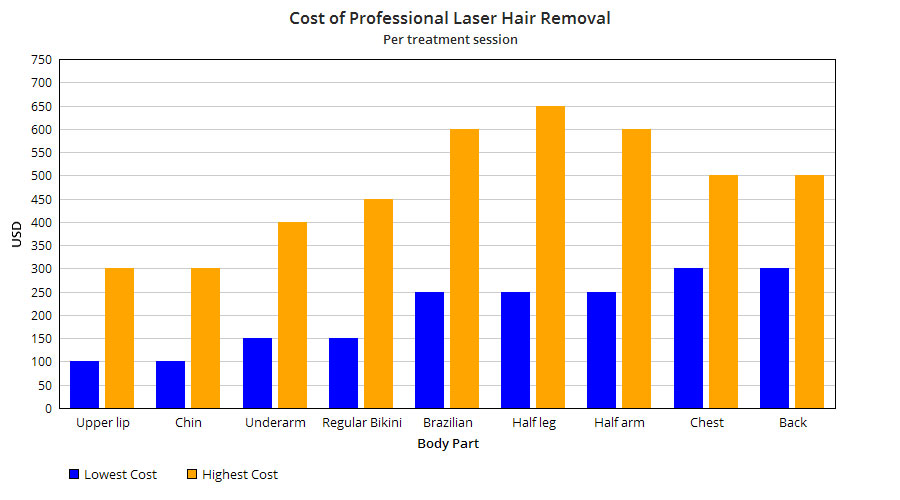Laser and Intense Pulsed Light (IPL) are both light-based hair removal methods which are often mistaken for each other but are in fact two separate technologies. Reputable clinics always use laser machines for treating unwanted hair, as they offer the best and most effective results in achieving long-lasting hair reduction. However, when it comes to DIY at-home solutions, IPL devices are most commonly used, as side effects are less common, and they’re more user-friendly.
Along with this, there’s actually only one at-home laser hair removal device in the market today, the Tria Laser 4X, which is another reason IPL is more commonly used. The Tria uses the same type of technology which professional laser machines use, the diode laser.
Laser vs IPL Hair Removal
Let’s take a closer look at each method to see their differences, and determine which works best for each individual. Keep in mind that it is also very important to understand that the word ‘permanent hair reduction’ shouldn’t be taken in a literal sense, as it needs to be continuously used to keep the hair reduction results. If you stop using the device, the hair will return.
The Mechanism: How Does it Work

IPL: Intense Pulsed Light is not a laser. Instead, these devices produce a broad spectrum of wavelengths (think of a light bulb) and cannot be focused to a concentrated beam. Because of the broad and different wavelengths, the light gets absorbed at a variety of depths within your skin, and only some of these are effectively absorbed by the hair follicle causing substandard results.
The Philips Lumea Advanced IPL is no doubt one of the most popular IPLs amongst its peers. It removes hair in up to 4-5 treatments and is safe to use.
Laser: Laser machines use more concentrated light energy (laser beam) which allows us to focus the energy directly at the hair follicle, achieving better results. Because the heat is absorbed by the follicle rather than the skin, there is a decreased risk of burning when using laser machines.
To put it simply, laser targets the hair follicles precisely, which gives you the sensation of being flicked with an elastic band on your skin, but doesn’t damage it. This also makes laser a safer option for darker skinned individuals since darker skin absorbs more light than light tones.
Skin Type Compatibility

IPL: As a general rule, the darker your skin tone, the more unsafe IPL is. This is because of two reasons. The first is that IPL technology is designed to seek out darker colors of hair, which are contrasted against the lighter colored skin. And the other reason is simple science; dark colors naturally absorb more light than lighter colors.
Due to the type of light and heat an IPL device generates, this can lead to burns or other negative side-effects. In short, IPL really only works on people with fairer skin types; Fitzpatrick Skin Types I, II, and III.
Laser: A laser machine uses a powerful and concentrated light beam to target and penetrate clusters of skin hair follicles. It targets the hair follicles precisely and doesn’t leave damage to the surrounding tissues. Because of this, laser is safe to use on patients with darker skin tones; Fitzpatrick Skin Types IV, V, and VI.
There are several types of laser machines that are being used for permanent hair reduction treatments. The most popular are Ruby, Alexandrite, and Diode, which are commonly used for pale skin types, while the other one is Nd:YAG, which is commonly used for darker skin tones. The Nd:YAG laser is safe for darker skin tones because of the longer wavelength it produces. The longer wavelength means the laser light is more reduced and less scattered, thus making it best for darker skin types.
| Type | Wavelength | Skin Compatibility |
|---|---|---|
| Ruby | 695 nm | Pale |
| Alexandrite | 755 nm | Pale to medium |
| Diode | 810 nm | Pale to medium |
| Nd:YAG | 1064 nm | Dark |
| Intense Pulsed Light | 650 nm | Pale to medium |
How Many Treatments Will I Need?
IPL: Since IPL isn’t as powerful as laser, it requires multiple treatment sessions to see full results; typically 8 to 12 treatments. This should result in a 60-75% reduction in hair growth lasting up to 6 months.
Laser: Results seen after 5 to 7 treatment sessions, with 75-80% reduction in hair growth lasting up to 6 to 12 months.
Note: Contrary to the claims of “permanent” hair removal, neither IPL or laser treatments permanently remove hair, they only give long term hair reduction. Touch up treatment is also necessary for continuous hair reduction result.
How Much Does it Cost?

Due to lasers mechanism and effectiveness, there are very few clinics which still utilize IPL machines for the reduction of unwanted hair. Clinics instead use laser machines due to their effectiveness in giving long term hair reduction results, and their ability to treat a wider range of skin types. The typical costs depend greatly on the body part that is being treated. The smaller the body part, the cheaper it is.
For bikini area or underarms, the lowest cost for laser hair removal is about $150 per treatment session (not including tips and taxes). Half arm starts at $250, half leg starts at $350. In addition, you would have to do it every 4 to 6 weeks to treat the new active hair growth. In short, you need 4 to 8 treatment sessions spaced every 4 to 6 weeks to finally achieve the long term hair reduction result.
What About Those Home-use IPL Device?

The effectiveness of these devices is still hotly debated among professionals. However, a clinical study was published in 2010 by a team of medical professionals to test the efficacy and safety of these home-use light-based gadgets.
The study actually returned favorable results, confirming the safety and efficacy of the device for hair removal at home. See the clinical study here. With this study in mind, using IPL for removing unwanted hair over long term use is considered a relatively cheap alternative to professional laser treatments. For example, a home IPL device costing only $200 can treat one or two body parts and can deliver results just after 3 to 7 treatments.
IPL Hair Removal Pros and Cons
There are several advantages of choosing IPL over laser. These include:
- Users who’ve used both report less pain associated with IPL treatments.
- Lower risk of skin damage or infection compared to laser (for lighter skinned individuals).
- Recommended and more efficient to treat larger areas such as chest and back.
- May be cost-effective as there are now many FDA-cleared IPL devices available for home use.
These are certain drawbacks to using IPL hair removal, including the following:
- Generally, IPL doesn’t work on darker skin types.
- May leave tan patches or discoloration on the skin, since the process damages the melanocytes — the skin color pigmentation cells.
- It does not work on red or grey hair.
Laser Hair Removal Pros and Cons
The following are the advantages of using laser hair removal over an IPL:
- Long term hair reduction result is more evident with the laser than the IPL.
- Different types of lasers available for different skin types. Ruby and Alexandrite lasers are recommended for pale skin tones. While Nd:Yag is recommended for darker skin tones.
- Safer option for darker-skinned individuals.
On the other hand, the following are the drawbacks of laser hair removal over an IPL:
- Slight discomfort a sensation like being flicked with an elastic band.
- May cause minor redness, itching, and swelling after the treatment.
- May also cause more serious complications, such as hyperpigmentation, scarring and changing the skin pigment color.
- More expensive especially when treating larger body parts.
Braun is one of the most popular hair reduction brands in the industry for their 100-day guarantee and effective IPLs. The Expert Pro 3 is a compact device that has smart skin sensors and can treat legs in just 9 minutes.
Ultimately, Which is Best For Me?
So which permanent hair removal method works best for you?
At this point, you’ve seen that both of these treatment options produce light energy that disrupts the growth cycle of the hair follicles, thus reducing hair growth without damaging the surrounding tissues. However, the similarities end there. The primary difference between the two lies in the type of technology used to generate light.
In terms of cost, IPL is the far more affordable option, as there are now many FDA-cleared IPL devices which are available and safe for home use. However, compliance, patience, and discipline with treatment sessions when using at-home IPL devices are an important aspect of the treatment process to achieve permanent hair reduction result. On the other hand, although a more expensive option, laser technology is generally more effective, achieving substantially better results for a longer period of time. The laser also works better with different skin types including individuals with darker skin tones.
For both procedures, it’s crucial to determine your skin type and hair color in order to choose the procedure that will suit you best. Even with laser hair removal treatments, this factor is very important in order to identify the correct settings for the machine. All of these issues will be discussed during the initial test patch consultation. Keeping all these factors in mind, you will be in a better position to make a well-informed decision regarding the best hair removal treatment for you.










